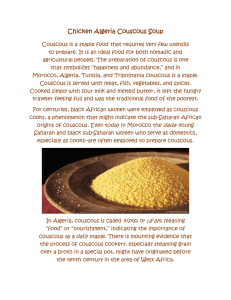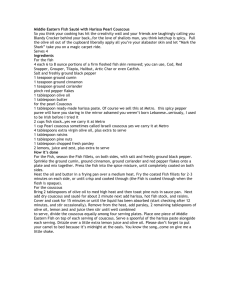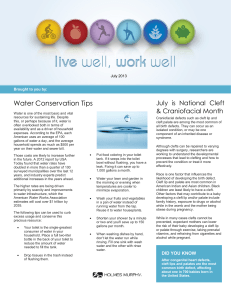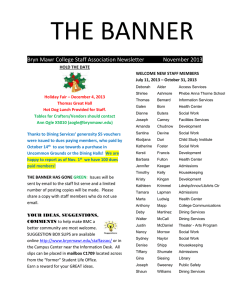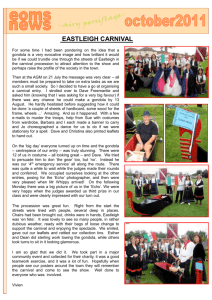Couscous Food $ense Kids
advertisement
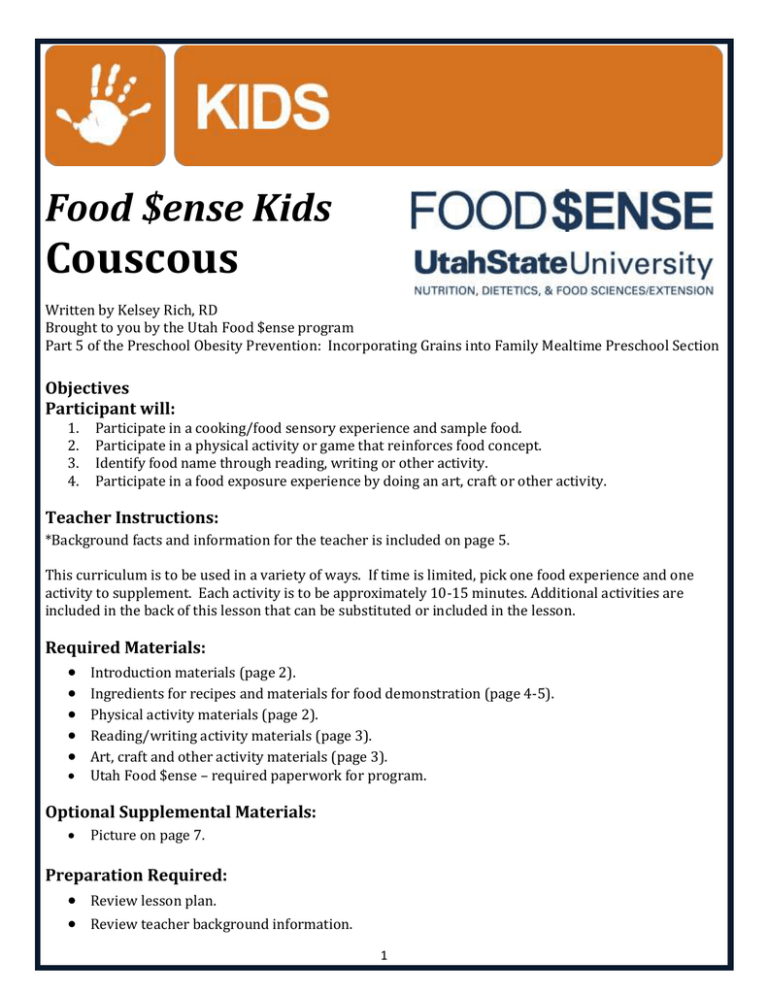
Food $ense Kids Couscous Written by Kelsey Rich, RD Brought to you by the Utah Food $ense program Part 5 of the Preschool Obesity Prevention: Incorporating Grains into Family Mealtime Preschool Section Objectives Participant will: 1. 2. 3. 4. Participate in a cooking/food sensory experience and sample food. Participate in a physical activity or game that reinforces food concept. Identify food name through reading, writing or other activity. Participate in a food exposure experience by doing an art, craft or other activity. Teacher Instructions: *Background facts and information for the teacher is included on page 5. This curriculum is to be used in a variety of ways. If time is limited, pick one food experience and one activity to supplement. Each activity is to be approximately 10-15 minutes. Additional activities are included in the back of this lesson that can be substituted or included in the lesson. Required Materials: Introduction materials (page 2). Ingredients for recipes and materials for food demonstration (page 4-5). Physical activity materials (page 2). Reading/writing activity materials (page 3). Art, craft and other activity materials (page 3). Utah Food $ense – required paperwork for program. Optional Supplemental Materials: Picture on page 7. Preparation Required: Review lesson plan. Review teacher background information. 1 Gather ingredients and materials needed to demonstrate the recipes (page 4). Prepare materials for objectives 2, 3, and 4. Make copies of recipes and take home messages handout you wish to distribute (page 13) – enough for all class participants to take home to families. Make copies of all required paperwork for lesson. LESSON PLAN Introduction Time: 5 minutes Show the class some dry couscous. Place it in a small cup or plastic bag and pass it around. Ask the class: Does anyone know what it is? Has anyone tasted couscous before? What color is it? What food group does it belong to? Grain o Couscous is made by grinding a hard wheat. It is grinded until it makes the little pieces. How can we eat couscous? o Explain to them that couscous is kind of like a pasta. It is often used in salads and stews. It is frequently eaten with meat (chicken) and sauces. Objective 1: Participate in a cooking/ food sensory experience and sample food. Time: 15 minutes Choose a recipe that will work for your lesson: Jazzed Up Couscous Seasoned Couscous Hot Breakfast Couscous Objective 2: Participate in a physical activity or game that reinforces food concept. Time: 5-10 minutes “Go, Glow, Grow” Tell the children that the grains (like couscous) help us “go” because they give our bodies energy to think, run, and play. Fruits and vegetables help us “glow” because they have vitamins in them that help our body work right. Milk and beans (protein) help our bodies grow because they make our muscles and bones strong. Have the children stand in a circle. Show the pictures on pages 7-9 to the children. Explain to the children that when you show the picture of couscous they should run in place. When you show them the picture of the vegetables they should put their hands out to the sides of their face, and when you show them a picture of the black beans they should jump up and down. Objective 3: Identify food name through a reading, writing or other activity. Time: 10-15 minutes The Couscous Treasure Map o Print map on page 11 and crinkle it up to make it look old like a treasure map. o Print the camels on page 10. Give each child a camel. o Ask the children what the word couscous starts with. Explain that it starts with a C. 2 o Explain to the children that Charlie the Camel’s favorite food is couscous. He is in the hot desert and is very hungry. Charlie needs our help to get to the couscous. o Have the children take turns coming up to the map. When it is their turn, have the child think of a word that starts with the letter “C”. After they say a word with the letter “C” they can put their camel on a letter “C” on the map. Start with the “C” on the bottom right and follow the trail. The goal is to get the camel to the couscous so he can eat it. Objective 4: Participate in a food exposure experience by doing an art, craft, or other activity. Time 5 -10 minutes Couscous Patterning o Show the children the word couscous on page 11. Explain to the children that the word “couscous” is a pattern. Then have the children complete the worksheet on page 12. The children are to color the white shapes with the correct color to complete the pattern. __________________________________________________________________________ Conclusion: Time: 5 minutes Where does it come from? How can you eat it? What food group does couscous belong to? What does the grain group do for your body? Resources : http://allrecipes.com//Recipe/black-bean-and-couscous-salad/Detail.aspx http://www.foodnetwork.com/recipes/ina-garten/curried-couscous-recipe/index.html This material was funded by USDA’s Supplemental Nutrition Assistance Program – SNAP. The Supplemental Nutrition Assistance Program (SNAP) provides nutrition assistance to people with low income. It can help you buy nutritious foods for a better diet. To find out more, contact 1-800-221-5689 or visit online at http://www.fns.usda.gov/snap/. In accordance with Federal Law and U.S. Department of Agriculture policy, this institution is prohibited from discriminating on the basis of race, color, national origin, sex, age, religion, political beliefs or disability. To file a complaint of discrimination, write USDA, Director, Office of Civil Rights, 1400 Independence Avenue, S.W., Washington, D.C. 20250-9410 or call (800)795-3572. 3 RECIPES TOPIC: COUSCOUS Jazzed Up Couscous Ingredients: 10 oz. box Couscous 1 ½ C. boiling Water 2 T. Olive Oil ½ Onion, diced 2 cloves garlic, minced 3 Roma tomatoes, diced ½ C. Shredded Cheddar-Monterey Jack cheese Directions: Stir together couscous and boiling water in large, heatproof bowl. Set aside. Heat olive oil in skillet over medium heat. Stir in onions and garlic. Cook until the onion has softened and turned translucent (about 5 min). Add diced Roma tomatoes, cook until they release juice and mixture begins to thicken. Add tomato mixture and cheese to couscous. Seasoned Couscous Ingredients: 2 C. Water 1 T. Butter 1 T. dried Parsley flakes 2 tsp. Chicken Bouillon Granules ½ tsp. dried minced Onion ½ tsp. dried Basil 1/8 tsp. garlic powder Salt and Pepper to taste 10 oz. Couscous Directions: In saucepan, combine everything but couscous. Bring to boil. Remove from heat, stir in couscous. Cover and let stand for 5 minutes. This material was funded by USDA’s Supplemental Nutrition Assistance Program – SNAP. The Supplemental Nutrition Assistance Program (SNAP) provides nutrition assistance to people with low income. It can help you buy nutritious foods for a better diet. To find out more, contact 1-800-221-5689 or visit online at http://www.fns.usda.gov/snap/. In accordance with Federal Law and U.S. Department of Agriculture policy, this institution is prohibited from discriminating on the basis of race, color, national origin, sex, age, religion, political beliefs or disability. To file a complaint of discrimination, write USDA, Director, Office of Civil Rights, 1400 Independence Avenue, S.W., Washington, D.C. 20250-9410 or call (800)795-3572. 4 Hot Breakfast Couscous Ingredients: 2 C. Skim Milk 2 T Honey 3 tsp. Honey 3 tsp. ground Cinnamon 2 C. dry Couscous 1/3 C. Raisins ½ C. slivered Almonds Directions: In a saucepan over medium heat, combine milk, honey and cinnamon. When it comes to a boil, stir in couscous. Turn off heat, cover and let stand for 5 minutes. Sir in raisins and almonds. Couscous is a granular grain that originated from North Africa . It is made from semolina (coarsely ground durum wheat). Couscous is similar to a pasta or rice. When cooked properly it is light and fluffy, not gritty. Couscous found in most supermarkets is pre-steamed, this makes it much quicker to prepare than pasta or rice. Whole wheat couscous can also be purchased at most supermarkets. It is generally eaten with vegetables or chicken. ____________________________________________________________________ This material was funded by USDA’s Supplemental Nutrition Assistance Program – SNAP. The Supplemental Nutrition Assistance Program (SNAP) provides nutrition assistance to people with low income. It can help you buy nutritious foods for a better diet. To find out more, contact 1-800-221-5689 or visit online at http://www.fns.usda.gov/snap/. In accordance with Federal Law and U.S. Department of Agriculture policy, this institution is prohibited from discriminating on the basis of race, color, national origin, sex, age, religion, political beliefs or disability. To file a complaint of discrimination, write USDA, Director, Office of Civil Rights, 1400 Independence Avenue, S.W., Washington, D.C. 20250-9410 or call (800)795-3572. 5 Preschool Curriculum Couscous Background Teaching Information Couscous is a species of pasta made from coarsely ground semolina (hard wheat). It originates from North Africa. Rather than being in the form of noodles or extruded shapes, couscous is granular. The raw pieces are roughly the size of coarse sugar grains. Properly cooked couscous is light and fluffy, not gummy or gritty Couscous is made by grinding semolina. The semolina is sprinkled with water and rolled with the hands to form small pellets, sprinkled with dry flour to keep them separate, and then sieved. Any pellets which are too large to be finished granules of couscous and fall through the sieve will be again rolled and sprinkled with dry semolina and rolled into pellets. This process continues until all the semolina has been formed into tiny granules of couscous. This process is very laborintensive. In the traditional method of preparing couscous, groups of women would come together and make large batches over several days. These would then be dried in the sun and used for several months. In modern times, couscous production is largely mechanized, and the product is sold in markets around the world. The couscous that is sold in most Western supermarkets has been pre-steamed and dried, the package directions usually instruct to add 1.5 measures of boiling water or stock and butter to each measure of couscous and to cover tightly for 5 minutes. The couscous swells and within a few minutes it is ready to fluff with a fork and serve. Pre-steamed couscous takes less time to prepare than regular couscous, most dried pasta, or dried grains (such as rice). Whole Wheat Couscous is made with whole grain Durum Flour and often rolled with Brown Rice Flour. This flour retains the bran and germ of the Wheat Berry, thereby, making it more nutritious than products made from White Flour. The Whole Wheat variety of Couscous cooks just as quickly as the regular varieties. Couscous has a more vitamins than pasta. It contains twice as much riboflavin, niacin, vitamin B6, and folate, and containing four times as much thiamine and pantothenic acid. Couscous has the same amount of protein as pasta, and 1 gram of protein more for every 100 calories than white rice. Couscous is very versatile. It can be used in stews, salads, or as a replacement for pasta or rice. It is often eaten with vegetables and chicken. Resources: http://www.dunx.org/persona/food-couscous.html http://www.cliffordawright.com/caw/food/entries/display.php/id/58/ http://www.gourmetspot.com/ask/couscous.htm http://www.purcellmountainfarms.com/Whole%20Wheat%20Couscous.htm http://en.wikipedia.org/wiki/Couscous This material was funded by USDA’s Supplemental Nutrition Assistance Program – SNAP. The Supplemental Nutrition Assistance Program (SNAP) provides nutrition assistance to people with low income. It can help you buy nutritious foods for a better diet. To find out more, contact 1-800-221-5689 or visit online at http://www.fns.usda.gov/snap/. In accordance with Federal Law and U.S. Department of Agriculture policy, this institution is prohibited from discriminating on the basis of race, color, national origin, sex, age, religion, political beliefs or disability. To file a complaint of discrimination, write USDA, Director, Office of Civil Rights, 1400 Independence Avenue, S.W., Washington, D.C. 20250-9410 or call (800)795-3572. 6 7 8 9 10 11 12 Couscous Patterning! The word COUSCOUS is a pattern! Color in the white shapes to complete the pattern. 1. 2. 3. 4. 13
